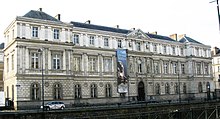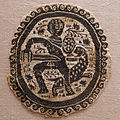Musée des Beaux-Arts (Rennes)
The Musée des Beaux-Arts (German: Museum of Fine Arts) is a state art museum in Rennes . It houses works of art from ancient times to the present. One focus of the collection is on French paintings from the 19th century.
history
The Rennes Museum was founded in 1794 during the French Revolution . The first objects in the collection included works of art confiscated from churches and private homes in the city. These included Egyptian and Greek antiquities, Celtic art , paintings, drawings and sculptures. A substantial part of it came from the collection of Christophe-Paul de Robien (1698–1756), the former President of the Parlement de Bretagne . The museum was initially located in the palace of the Bishop of Rennes .
The French state transferred to the museum between 1801 and 1811 a. a. Significant works from the Louvre thanks to the Chaptal Decree , which were no longer needed there when numerous captured works of art filled the museum during the Napoleonic Wars. For example, the Descent from the Cross by Charles Le Brun and Perseus saves Andromeda by Paolo Veronese found their way into the collection of the museum in Rennes. In the 19th century, numerous purchases were made at state exhibitions. The Paul Lucas Collection with old Italian masters is one of the important foundations and legacies of the following years.
Since 1855 the museum has been located in the then newly built Palais Universitaire . The building was first built by the architect Charles Millardet and later by Vincent Boullé as a four-wing structure with an inner courtyard in the classicism style. In addition to the art collection on the first floor, the palace initially also housed the university's natural science collections, parts of the university library and other university facilities. These moved to other locations in the following decades.
In the 1950s, the museum was extensively renovated and the damage to the building during the Second World War was removed. After 1945 the collection was expanded to include works from the 20th century and contemporary art. The current director (2013) of the museum is Anne Dary .
collection
The collections of the Musée des Beaux-Arts range from ancient Egyptian objects to contemporary art. In the Egyptian Art Department, for example, there are paintings on wood that come from mummy coffins from Thebes . There are also Coptic textiles , Greek and Etruscan ceramics and Roman sculptures. In the area of non-European cultures, the museum shows, for example, Indian paintings, Japanese kimono, lacquer work as well as sculptures and other objects from Asia.
The museum's collection of paintings consists mainly of works by French artists, with a focus on 19th century painting. Older French works include Baroque works such as A Festival Society at the Time of Henry IV by Louis de Caullery , The Newborn Child by Georges de la Tour , Hagar and Ismael Are Saved by the Angel by Eustache Le Sueur , the Descent from the Cross by Charles Le Brun , Allegory of the Paper Timbre Strike of 1675 by Jean-Bernard Chalette , Rural Interior by Sébastien Bourdon or Cleopatra Commits Suicide by Claude Vignon . Works such as The Resurrection of Christ by Noël Coypel , Girl with a Mask by Jean Raoux , Fruit Still Life with a Glass by Jean Siméon Chardin or the Portrait d'Innocente Guillemette de Rosnyvinen de Pire by Charles André van Loo date from the 18th century . There is also a trompe l'Oeil with a statuette of Hercules by Jean Valette-Penot , a girl with a blue hairband by Jean-Baptiste Greuze , as well as travelers surprised by the storm and robbery by night by Philipp Jakob Loutherbourg the Younger .
In the field of Dutch painting, the museum mainly shows works from the Baroque period. These include the paintings The Festival of the Gods (16th century) by Bernard Ryckere , The Denial of Saint Peter (around 1620) by Gerrit van Honthorst , a portrait of Ambrosius of Milan (around 1633–39) by Matthias Stomer and the historical picture Die Wedding of Prince Friedrich Wilhelm von Brandenburg with Luise Henriette von Oranien (1646) by Johannes Mijtens . The painting Saint Luke paints the Virgin (around 1545) by Maarten van Heemskerck is more likely to be assigned to the Mannerist style . The Flemish painting collection includes the Portrait of a Woman (16th century) by Adriaen Thomasz Key , Interior of a Church (1652) by Anthonie Delorme and Entry into the Ark (17th century) by Isaak van Oosten . There is also a penitent Magdalena (1657) by Philippe de Champaigne and a tiger and lion hunt , (1617–1618) by Peter Paul Rubens . The museum also has a portrait of Françoise Louise with her children as angels by the Englishman Peter Lely or Perseus saves Andromeda by the Venetian Paolo Veronese .
In the field of French classicism painting , the museum shows a portrait of Alexander the Great by Charles Meynier , a portrait de Paulin des Hours Farel by Antoine-Jean Gros or the Massacre of the Innocents by Léon Cogniet . There are also The Last Morning of Marie-Antoinette by Louis Baader and The Horse by Gaada by Louis-Eugène Ginain . Works such as the paintings Danae by Alexandre-Jacques Chantron , Zouave à la fontaine by Étienne Prosper Berne-Bellecour , Solitude, Huelgoat by Paul Sérusier and La marine bleue by Georges Lacombe date from the second half of the 19th century . By Gustave Caillebotte , the museum owns the portrait of Henri Cordier and canoes on the Yerres , by Paul Gauguin , the Still Life with Oranges and a vase of flowers . An example of 19th century Dutch painting is the still life A Bunch of Garlic and a Pewter Jug by Meijer de Haan . Other works by foreign artists are the artist's studio of the Spanish painter Lorenzo Vallés or the valley of the Seine near Saint-Cloud by Belgian Alfred Stevens, who worked in France .
Maurice Denis marks the transition to the 20th century with his pictures. His painting Joel with the horse in the forest of Perros was made around 1896, the picture The first steps from 1911 . The museum also features the cityscape of Rue Sainte-Rustique, Montmartre by Maurice Utrillo , the war picture Exodus by Robert Houdusse and the surrealist work Inspiration by Yves Tanguy . The museum is showing the picture Head of a Woman by Pablo Picasso from his classical work phase.
The museum also has an extensive collection of drawings. This includes works by Albrecht Dürer , Domenico Ghirlandaio , Parmigianino and Rembrandt van Rijn . One of the highlights of this collection area is a drawing with a study of a robe by Leonardo da Vinci . For example, a chalk drawing by Pablo Picasso, on which he portrayed his son Paulo, dates from the 20th century.
In the field of contemporary art collection, the Rennes Museum has set different priorities. In addition to poster artists, the museum is increasingly dedicated to artists from Brittany. The museum also collects works of abstract art from Sam Francis to Aurelie Nemours .
The sculpture collection shows works such as Messalina by Eugène Cyrille Brunet or Junge im Jonchets-Spiel by Julien-Charles Dubois . Well-known works include a Buste de jeune femme by Auguste Rodin or an Elephant by Rembrandt Bugatti . A crowned crane by Anne-Marie Profillet can also be seen.
literature
- François Coulon: Musée des beaux-arts de Rennes, Guide des collections. Réunion des musées nationaux, Rennes 1996, ISBN 2-7118-3429-8 .
Web links
Coordinates: 48 ° 6 ′ 34 " N , 1 ° 40 ′ 30" W.










